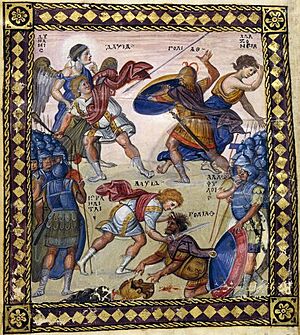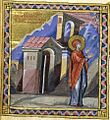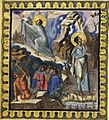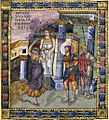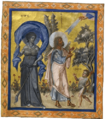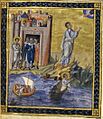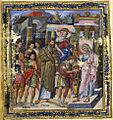Paris Psalter facts for kids

The Paris Psalter (Paris, Bibliothèque Nationale, MS. gr. 139) is a very special Byzantine book. It's an illuminated manuscript, which means it's a handwritten book with beautiful pictures. This book is about 38 by 26.5 centimeters in size. It has 449 pages (called folios) and 14 amazing full-page pictures.
The Paris Psalter is a key example of something called the Macedonian Renaissance. This was a time in the 10th century when people in the Byzantine Empire became very interested in old Greek and Roman art styles again. This artistic movement is linked to Emperor Constantine VII Porphyrogenitus (who lived from 909 to 959) and the rulers who came after him.
Contents
What is the Paris Psalter?
The Paris Psalter is a copy of the 150 Psalms of David. These are like songs or prayers from the Bible, originally written in Hebrew. In this book, they are translated into Greek. After the Psalms, there are more prayers called the Canticles of the Old Testament.
These kinds of books were very popular for people to use at home for their private prayers. Many fancy copies were made for kings, queens, and rich families. The Paris Psalter is one of the best examples of these luxurious Byzantine books.
The book also has many notes and explanations around the main text. These notes help explain the prayers and come from older religious writings. Even though the notes are written in smaller letters, they take up much more space on each page than the Psalms themselves. This means that longer Psalms can spread across many pages.
Books with lots of notes were usually made for libraries in monasteries, or for religious scholars. But the Paris Psalter looks very grand and has pictures that remind us of ancient kings. This suggests it was made for an emperor, possibly Emperor Constantine VII himself. He was known for being very smart and interested in both learning and religion.
How the Book Was Made
The Paris Psalter was written in a special style of handwriting called minusucule bouletée. This handwriting looks very similar to other Byzantine books from the same time. These other books include a gospel book (Parisinus graecus 70), another Gospel Book (London, British Library Add MS 11 300), and several others. It's very likely that all these books, including the Paris Psalter, were made in the same workshop in Constantinople.
Amazing Art and Pictures
The most important part of the Paris Psalter for art history is its 14 stunning full-page pictures. These pictures were drawn on separate pages and then added into the book.
The first seven pictures show scenes from the life of David, who wrote the Psalms. Often, David is shown with characters who represent ideas like "Melody" or "Strength." The eighth picture marks the start of the "penitential Psalms" (prayers about saying sorry). The last six pictures show other important Bible figures like Moses, Jonah, Hannah, Ezekiel, and Hezekiah. These pictures introduce and illustrate the Canticles (more prayers) from the Old Testament.
Here are some of the scenes shown in the pictures:
- 1v: David playing his harp with Melody sitting next to him.
- 2v: David fighting and killing a lion, helped by Strength.
- 3v: Samuel anointing David (making him king), with Lenity (gentleness) watching.
- 4v: David, helped by Power, defeats Goliath, while Arrogance runs away.
- 5v: David returns to Jerusalem in triumph.
- 6v: David is crowned king by Saul.
- 7v: David stands with an open Psalter, joined by Wisdom and Prophecy.
- 136v: Nathan tells David off about Bathsheba; David shows he is sorry with Repentance.
- 419v: Moses parting the Red Sea, with characters representing the desert, night, the deep sea, and the Red Sea.
- 422v: Moses receiving the Ten Commandments.
- 428v: Hannah thanking God for her son Samuel.
- 431v: Scenes from the story of Jonah.
- 435v: Isaiah with Night and Dawn.
- 446v: King Hezekiah.
An expert named Jean Porcher believes that five different artists worked on these full-page pictures. He thinks the main artist, called Hand A, painted six of them.
The David Composing the Psalms Picture
The picture on page 1v shows David playing his harp. Next to him sits a character representing Melody. To David's right, a nymph named Echo watches him play. In the bottom right corner, a character representing Mount Bethlehem is shown relaxing. David is surrounded by sheep, goats, and a dog. This scene reminds us of the ancient Greek myth of Orpheus, who could charm animals with his music.
The setting of the picture is a beautiful, natural landscape, like those seen in ancient art. There are trees, bushes, and tall reeds, along with mountains, valleys, and a stream. This might be a nod to an old Roman mosaic that showed Orpheus charming animals. However, this picture also includes a view of the city of Bethlehem in the top left corner, which is a Christian detail. The way Melody and David are shown together is also very much like classical art, where loving couples were often pictured. Here, this style is used to tell a Christian story.
This picture has two main meanings: a religious one and a political one. Religiously, David is shown as a figure similar to Christ. Politically, David is presented as an example of a perfect king or leader. The idea of Orpheus charming beasts also suggests that a good ruler can calm his enemies, just as David did.
The David and Goliath Picture
The picture on page 4v shows the famous battle where young David defeats the giant Goliath. This painting also celebrates the rulers of Macedonia, suggesting that their power came from God. It can also be seen as a symbol of Christ's victory over evil, or a ruler's victory over an enemy.
The Paris Psalter is very famous in ancient Byzantine art. While there are many other illuminated Psalters, this one is considered the most well-known among the seventy-five that still exist. A common idea in the Paris Psalter is showing ideal rulers. This was meant to highlight their importance and make them seem glorious.
The story of David and Goliath begins when the Philistine army and Saul's army were about to fight. Goliath, a huge Philistine, kept challenging Saul's army, but no one dared to fight him. David's older brothers were in Saul's army, but David was too young to fight and stayed home. When David brought supplies to his brothers, he felt determined to defeat Goliath for his people. With King Saul's permission, David went to fight Goliath, and the famous conflict began. This story inspired the picture of David's victory over Goliath in the Psalter.
History of the Paris Psalter
When scholars first saw the Paris Psalter in the 1800s, its art style looked so much like ancient Roman art that they thought it was made in the early 500s. But in the early 1900s, experts like Hugo Buchthal and Kurt Weitzmann proved that the detailed and realistic style of the pictures was actually from the 900s. This showed that classical art styles continued to be important in the Byzantine Empire much longer than people thought.
Most of the full-page pictures show important moments from the life of King David. The pictures hint that David wrote the Psalms. But scenes like Samuel anointing David and David being crowned by Saul also show that David was chosen by God to be a ruler. This focus on kingship and the classical art style made scholars believe that Emperor Constantine VII Porphyrogenitus (who lived from 905 to 959) might have ordered or owned this book. This would mean it was made in the emperor's own workshop.
Constantine VII was known for loving classical writings and for his own artistic talents. He might have even watched over the artists who made the Psalter. Whether the book was for Constantine VII himself, or a gift for his son Romanos II when he became co-emperor in 945, the stories and pictures of David would have taught them about how a Christian emperor should rule and behave.
Even though the amazing classical style and focus on kingship strongly suggest Emperor Constantine VII was involved, the first clear records of the book are copies of some of its pictures found in other books from the 1200s. These copies suggest the Paris Psalter was in the imperial library even after Latin rulers were forced out of Constantinople. It continued to be highly valued in later Byzantine times.
The known history of the book begins in 1558. That's when Jean Hurault de Boistaillé, the French ambassador to Constantinople, bought the book from the Sultan Suleiman I. A note on the first page (fol. 1r) records the purchase: "From the library of Jo. Huralti Boistallerii. I got it from Constantinople for 100 crowns." The Hurault family's library was later bought by the French royal library in 1622. This library eventually became the main collection of the Bibliothèque nationale de France.
Images for kids


